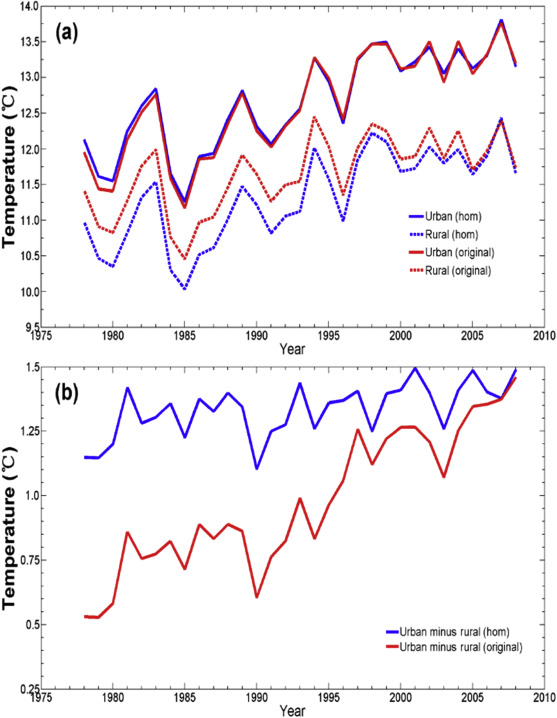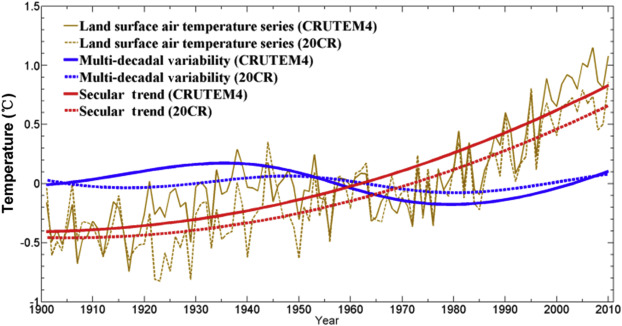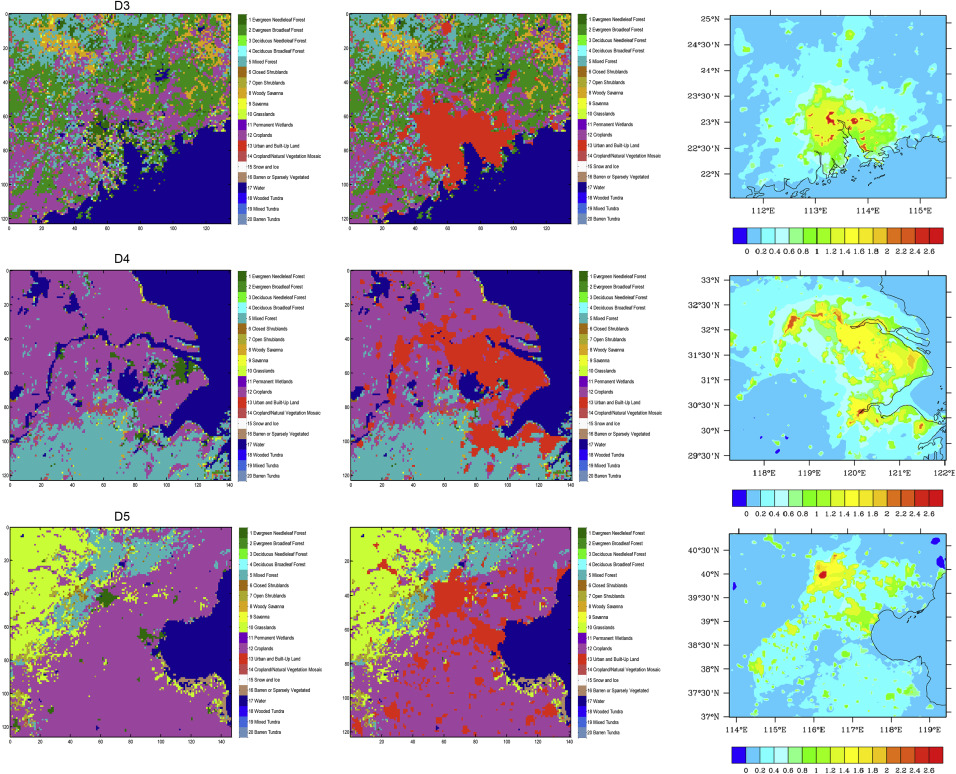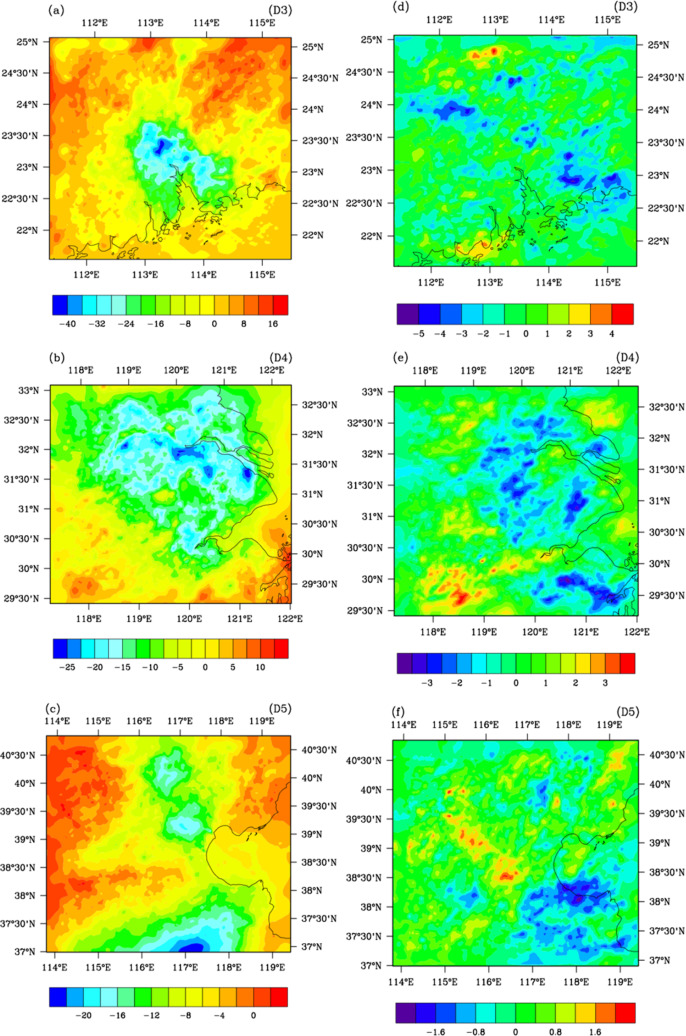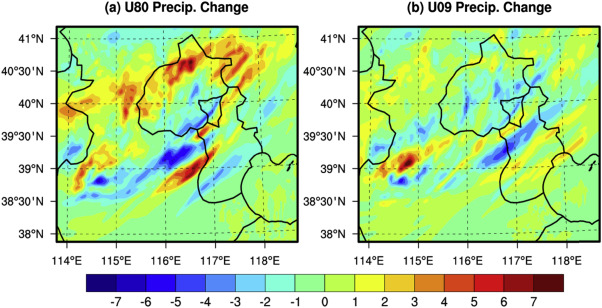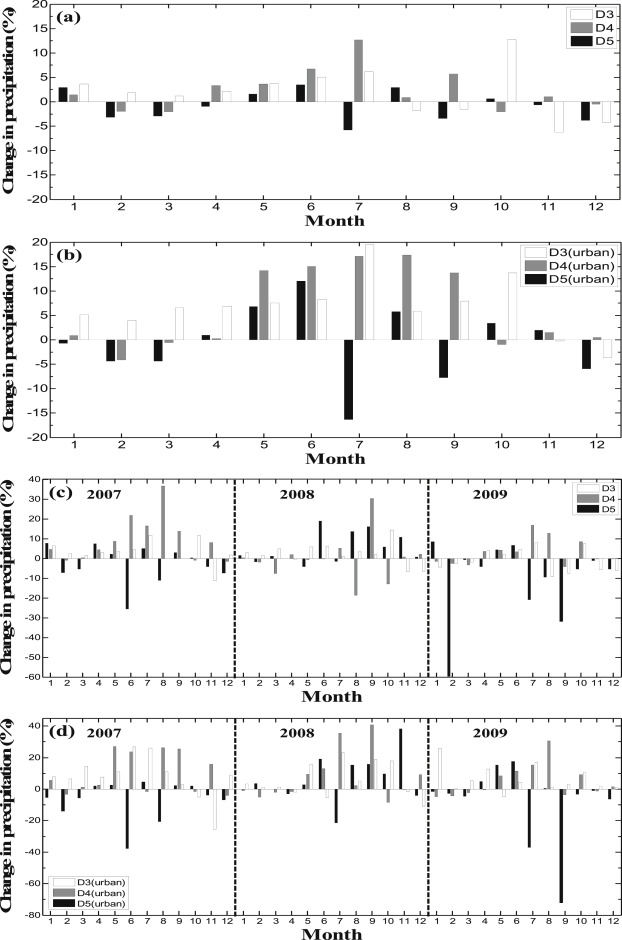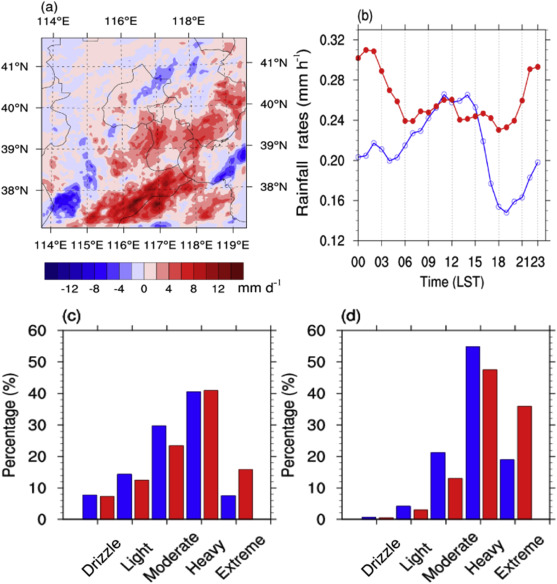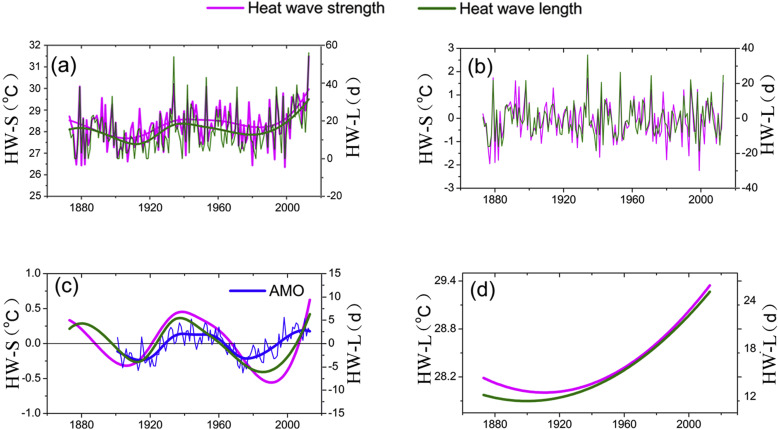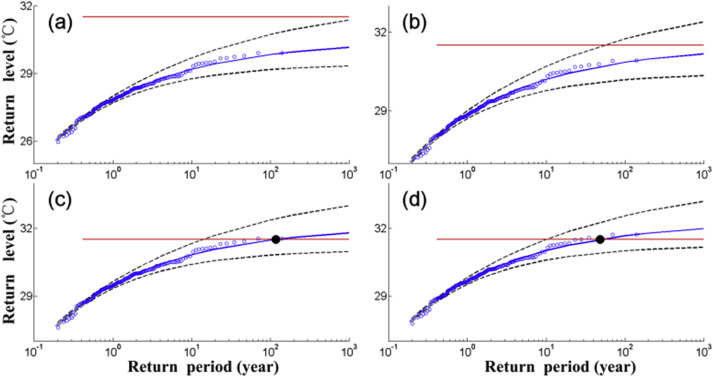Abstract
This paper summarizes recent studies on the effects of urbanization on climate in China. The effects of urbanization on local climate trends have been re-estimated based on homogenized observations and using improved methods. In this respect, the effect of urbanization on the observed warming trend of local surface air temperatures during the last few decades is determined as being about 20% at urban stations such as the Beijing Observatory. The large-scale weakening trend of wind speed is also about 20% more prominent at the city center than its surroundings. The effect of urbanization on precipitation is not profound, but results of high-resolution regional climate modeling suggest that this effect may depend on the urban extent. Although the urban heat island (UHI) should favor local atmospheric convection and hence precipitation, the increasingly extending urban land-use may reduce precipitation over the urban cluster in North China. It is found that urbanization can play a more notable role in extreme events than usual weather. High-resolution simulations show a positive feedback between the UHI and the super-heat wave in Shanghai during July–August 2013. Relevant studies dealing with urban climate adaptation are discussed in relation to recent findings.
Keywords
Regional climate change ; Urbanization effect ; Homogenized observation series ; High-resolution modeling ; Climate adaptation
1. Introduction
Although it is evident that urbanization significantly influences the local climate, the degree to which this occurs has not yet been adequately determined. China represents a good study ground in this respect because there has been rapid development within the country over the past few decades. According to the National Bureau of Statistics of China, the urban population has been over 50% in recent years and will be over 80% by 2050. Study of the effects of urbanization on climate is receiving increasing attention because of the increasing threat to urban lives from extreme weather or climate events such as persistent heat waves (Chen et al., 2014 ), torrential rain (Wang et al., 2015 ), and severe haze (Tao et al., 2015 ).
The present paper summarizes recent studies, with the aim of gaining an understanding and quantification of the typical effects of urbanization on climate, in addition to promoting further studies on urban adaptation in a rapidly developing region. Section 2 reports the effects of urbanization on observed local trends in surface air temperature, wind speed, and precipitation. Section 3 explains mechanisms involved in these effects based on high-resolution regional climate simulations. Section 4 discusses urban influences on climate extremes. Finally, Section 5 discusses future study prospects, particularly with respect to implications for urban adaptation to climate change.
2. Effects of urbanization in climate observations
2.1. Surface air temperature (SAT)
The most well-known urban climate feature is the so-called urban heat island (UHI) effect. The UHI is gradually enhanced as the urban environment develops and an increasing trend of SAT is usually noted in local observation series, in comparison with trends at nearby rural stations (Lin and Yu, 2005 ; Ren et al., 2007 ; Yan et al., 2010 ; Wang et al., 2013a ; Ren and Zhou, 2014 ). Many authors have estimated the contribution of urbanization to the observed warming trend in China, thereby providing a large range of results (Wang et al., 1990 ; Portman, 1993 ; Li et al., 2004 ; Li et al., 2010 ; Zhou et al., 2004 ; Hua et al., 2008 ; Jones et al., 2008 ; Ren et al., 2008 ; Yang et al., 2011 ; Wang and Ge, 2012 ; Wu and Yang, 2013 ). However, most of these previous papers have tended to overestimate the urbanization contribution. For example, Portman (1993) determined the urban-induced warming trend in North China to be over 0.1 °C per decade, even prior to the 1990s.
However, there are two other actual factors that contribute to the overestimation. The first is inhomogeneity in the observed SAT series due to changes in the local observing system (e.g., site relocations and instrumental updates during station history). For instance, based on original SAT observations, Ren et al. (2007) estimated that the urban contribution to the observed warming trend at Beijing Observatory could be over 80%, whereas the result of Yan et al. (2010) estimated a modest 40% after they had adjusted the inhomogeneous biases in the SAT series due to two major site-moves of the observatory. However, the result of Wang et al. (2013a) was further reduced to about 20%, based on a fully homogenized dataset for the whole of the Greater Beijing Region (GBR). Although there are other reasons for differences in estimates, such as the data on different time periods and differing choices of reference stations, homogenization of an observation series is undoubtedly beneficial for reducing uncertainty in estimations of the urban effect. Similar results can be found for other regions around the world, such as the U.S. (Peterson, 2003 ).
It is interesting to explore the reason why homogenization of local observations usually leads to smaller estimates of the urban warming trend. The need for homogenization is particularly relevant in China, as many stations were relocated to rural sites during the rapid development period to meet standard requirements for meteorological observations. Such relocations more frequently happened for rural stations and usually induced a cooling bias in the time series of SAT, causing an underestimation of the warming trends at rural stations and hence an overestimation of the urban effect. This is the case for the GBR, as well as for some other regions over the world (Hansen et al., 2001 ). Fig. 1 a shows that for GBR during the last few decades the warming trend in the original observations of rural stations is weaker than that apparent in the homogenized series. In Fig. 1 b, the urban-rural temperature difference for the region is seen to increase abruptly in the 1990s; this is unlikely to be related to the gradually enhancing UHI over the region and is undoubtedly the inhomogeneity in the observation series.
|
|
|
Fig. 1. (A) Original (red lines) and homogenized (blue lines) surface air temperature series at urban (solid lines) and rural (dashed lines) stations in Beijing; (b) urban–rural temperature differences determined by original (red line) and homogenized (blue line) observations (based on the daily temperature dataset in Li and Yan (2010) ). Urban stations include Beijing, Changping, Fengtai, Mentougou, Tongzhou, Haidian, and Shijingshan; rural stations include Huairou, Pinggu, and Miyun. More details can be found in Wang et al. (2013a) . |
Another source of uncertainty arises from the choice of techniques used to estimate the urban effect, e.g., different reference choices as mentioned above. For example, many studies have applied the urban minus rural (UMR) method, which involves making a comparison between the climatic trends at urban sites and those at nearby rural sites. The urban and rural sites were identified usually by indices of population (Hua et al., 2008 ), nighttime light intensity (Hansen et al., 2001 ), and remote-sensed land-cover data (Gallo et al., 1999 ), and different authors have set differing thresholds, thereby delivering differing results. Local differences in climatology and geography also need to be cautiously considered. For example, when estimating the urban effect at the Beijing Observatory it is not reasonable to compare results with those recorded at a nearby mountain site, which is as local as an urban site is, where the surface warming could be much weaker than on the plain even if no urbanization existed thereon (Pepin and Seidel, 2005 ). Wang et al. (2013a) suggested the use of objective clustering analysis for classifying stations within the region, which has helped reduce the uncertainty in estimating the urban effect.
Another impressive case is the observation minus reanalysis (OMR) method (Zhou et al., 2004 ; Yang et al., 2011 ). The basic idea of the OMR is that the model-reproduced reanalysis data represents large-scale climate change without taking into account the local effect of land-use change, such as urbanization (Kalnay and Cai, 2003 ), and therefore the relative trend in urban station observations can be used to reflect the effect of urbanization. Although its relevance is arguable (Vose et al., 2004 ; Trenberth, 2004 ; Cai and Kalnay, 2005 ), the OMR has been applied in many studies to estimate the urban warming effect in China. Having reviewed previous papers, Wang et al. (2013b) pointed out that an amount of systematic bias in multi-decadal variability (MDV) in the reanalysis data caused different (and even contradictory) OMR trends among different periods and regions. As shown in Fig. 2 , the amplitude of MDV in the reanalysis SAT series for the Northern Hemisphere land is weaker than that of station observations, particularly for the last few decades. It is thus obvious that systematic bias in MDV tends to cause overestimation of the urban effect for one period and underestimation for another. Having adjusted MDV in the reanalysis data, Wang et al. (2013b) concluded that the urban warming effect at Beijing and Shanghai should be less than 0.1 °C per decade, much smaller than many previous estimates but more consistent with the results of recent studies based on homogenized data.
|
|
|
Fig. 2. Averaged Northern Hemisphere land surface air temperature series (brown lines), ST (secular trend: long-term and non-linear trend; red lines) and MDV (multi-decadal variability; blue lines) based on CRUTEM4 (Climatic Research Unit Global Temperature Dataset Version 4) and 20CR (20th Century Reanalysis) datasets. From Wang et al. (2013b) . |
Zhao et al. (2014) conducted a different approach via statistical regression analysis of a set of homogenized long-term SAT series (reaching back to a century ago) in China. They concluded that more than 80% of the observed warming trend (1.5 °C per century) in the region could be explained by large-scale climate changes, including those of atmospheric circulation surrounding the region, and that any urbanization-related uncertainty ranged from 9% to 24% for different stations. Therefore, the overall contribution of the urban effect to the observed warming trend in China was much less than 20%. This inference is consistent with results from the Beijing Observatory, one of the most influenced sites in China, which infer that the urban effect has contributed to about 20% of the observed warming trend during the last few decades (Wang et al., 2013a ), thereby representing the upper-limit of the urban effect obtained from station SAT observations in China.
2.2. Wind speed
Another obvious effect of urbanization is a weakening wind speed in the city relative to the surrounding rural area, which is due to increased urban surface roughness. Based on near-surface wind records from stations in China during 1956–2004, Jiang et al. (2010) estimated that the effect of urbanization on wind speed trends was −0.01 m s−1 per decade.
Inhomogeneity may also cause a bias in estimates of the observed trend in local wind speed records. Li et al. (2011b) compared results based on original observations with those based on a homogenized wind speed dataset from the GBR for the period 1960–2008. Their results showed that wind speeds decreased over the whole region when based on homogenized data, and that the largest rate of decrease occurred near the city center. This was found to be a typical pattern of the urban influence on surface wind. In contrast, the original data showed no systematic pattern in the wind speed trends within the region. By comparing the decreasing rate at the city center with results from nearby rural sites based on homogenized data, Li et al. (2011b) concluded that the effect of urbanization in the annual mean wind speed series at the city center was about −0.05 m s−1 per decade, accounting for about 20% of the regional mean declining trend of wind speed.
It is evident that further studies are required to enable accurate estimations of the urbanization effect on near-surface wind speed in China, as there is fine-scale temporospatial variability in surface winds and local wind observations are prone to inhomogeneities due to various factors.
2.3. Precipitation
Due to the UHI-induced atmospheric circulation and aerodynamic effect of the urban canopy, it is likely that some precipitation patterns around the urban area are modified. For example, using radar-based images, Niyogi et al. (2011) found that storms split upwind of the urban area and merge in the downwind. Some authors have applied remote-sensing data (e.g., Tropical Rainfall Measuring Mission precipitation data) to identify patterns in warm-season precipitation anomalies around cities (Shepherd et al., 2002 ; Li et al., 2011a ; Zhang et al., 2014 ). Many studies have attempted to demonstrate the effect of urbanization on precipitation in China based on station observations (Chen et al., 2007 ; Miao and Chen, 2008 ; Miao et al., 2009 ; Wang et al., 2012a ; Yang et al., 2013 ; Dou et al., 2015 ). Some results showed that urbanization imposed detectable impacts on the changes in short-duration heavy rainfall frequency (Li et al., 2011a ) and total precipitation amount (Song et al., 2014 ) in urban areas.
Unlike the UHI effect, the urban effect on precipitation is usually not centered in the city but varies with different geographical and meteorological backgrounds. For assessing the urban effect in long-term station observations, it is beneficial to identify where in or around the city is likely influenced via statistical analyses (e.g., Wang et al., 2012a ; Han et al., 2014 ). Difficulties also arise in relation to the strong temporal and spatial variability of precipitation, which easily overwhelms any urban effect from the point of view of climate change.
In contrast to many studies that show urban rainfall enhancement, some studies have demonstrated that urbanization has a negative effect on precipitation (Zhang et al., 2009a ). For example, Kaufmann et al. (2007) found that urban-induced changes in regional surface hydrology may have reduced local precipitation in the Pearl River Delta in southern China.
It is therefore evident that further studies are required to gain a comprehensive understanding and estimation of the urban effect on precipitation in China.
3. Climate responses to urbanization in model simulations
3.1. Urban land-use
Urban land-use expands during urbanization and thus has an evident effect on the regional climate. The urban landscape is highly heterogeneous, and thus high-resolution regional climate modeling is beneficial for use in studying its influence. Early studies adopted a bulk parameterization for the urban area in a land surface model scheme (Liu et al., 2006 ), but this simplified scheme was not very adept at describing the complex interactions between the underlying surface and the atmosphere in the urban region. In recent years, urban canopy models have been developed as part of regional climate models, which has greatly improved the ability to model urban land-use (Kusaka and Hayami, 2006 ; Chen et al., 2011b ). High-resolution land-cover data are imperative for simulating the urban influence on climate; such datasets have been recently available for China and have thus been applied in high-resolution climate modeling.
Changes in SAT induced by urban land-use in China have been extensively simulated and documented in many modeling studies, with more or less consistent results (Zhang et al., 2010 ; Feng et al., 2012 ; Wang et al., 2012b ; Lin et al., 2016 ). Fig. 3 shows the simulated urban land-cover change from non-urban to the present situation with 3.3 km-resolution and the corresponding temperature change over the three urban agglomerations in China. The simulated SAT change due to urban land-cover change is about 0.3 °C on average over the three most extensive urban clusters in China, which is not greatly different from estimates based on homogenized long-term station SAT observations (as mentioned in the previous section).
|
|
|
Fig. 3. Land-use classifications and simulated changes in surface air temperature. Left column represents land-use classifications contained in WRF-UCM for Pearl River Delta (D3), Yangtze River Delta (D4), and Beijing–Tianjin–Hebei (D5) urban agglomerations in China, but with the urban type removed. Middle column represents land-use classifications used in WRF-UCM for D3, D4, and D5, with the urban fraction updated based on the Model Land Cover Data Sets, version 1.0. Y-axis and X-axis represent the numbers of grid cells. Right column represents geographical patterns of the simulated changes in annual surface air temperature in three domains: D3, D4, and D5. Units for temperature change are degree Celsius (Wang et al., 2012b ). |
For precipitation however, the simulated influence of urban land-use in China have diverse results (Guo et al., 2006 ; Lin et al., 2008 ; Zhang et al., 2009a ; Miao et al., 2011 ; Feng et al., 2012 ; Wang et al., 2012b ; Yang et al., 2014 ). Previous studies have suggested that urban land-use could favor atmospheric convective activities, thus increasing precipitation over and downwind of cities. The mechanisms involved in urban-induced enhancement of precipitation include: 1) the UHI effect ‒ when combined with the increased surface roughness, local atmospheric convergence and convective motion are enhanced, hence favoring precipitation; 2) the urban-induced thermodynamic perturbations in the atmospheric pressure field enhance the intrusion of sea or lake breezes, which invigorates atmospheric convection; 3) the urban canopy affects the intensity, composition, and structure of passing thunderstorms.
The negative influence of urban land-use on precipitation is also notable (Guo et al., 2006 ; Zhang et al., 2009a ; Wang et al., 2012b ). The main mechanism responsible for urban rainfall inhibition arises from the extensive replacement of natural vegetation and soil by impervious surfaces in the urban region, which suppresses evapotranspiration and surface moisture supply to the lower troposphere. Another feature of urbanization is the deepening of the atmospheric boundary layer, which leads to more evenly mixed water vapor. In addition, the decreased atmospheric water vapor mixing ratio causes less convective available potential energy and more convective inhibition energy, thus reducing precipitation over urbanized regions (Fig. 4 ).
|
|
|
Fig. 4. Changes in convective available potential energy (a, b, c) and precipitation (d, e, f) in summer due to urban land-use in the Pearl River Delta (D3), Yangtze River Delta (D4), and Beijing–Tianjin–Hebei (D5) urban agglomerations in China, respectively. Unit for convective available potential energy is J kg−1 ; unit for precipitation is mm d−1 (Wang et al., 2012b ). |
These competing mechanisms may explain the diverse results of observations in relation to the urban influence on precipitation. However, it is likely that differing mechanisms play a dominant role in different cases. For instance, as shown in Fig. 5 , Wang et al. (2015) pointed out that urban-induced precipitation anomalies depend on the scale of urban land-use: precipitation tended to increase in the downwind area of the Beijing metropolis in the early stage of the citys development in the 1980s, and there has been little change in this respect under the present situation of extensive urbanization. It is considered that the positive UHI effect may have played a dominant role in increasing downwind rainfall during the early urbanization stage; while the urban dry island effect could become more influential with expanding urban land-use in the region. However, these results rely quite on numerical simulations, of which uncertainty remains as an issue deserving further studies.
|
|
|
Fig. 5. WRF-UCM simulated changes in rainfall pattern due to urban land-use in the Beijing–Tianjin–Hebei urban agglomeration in China for the cases: (a) in 1980, and (b) in 2009 (units: mm h−1 ) (Wang et al., 2015 ). |
There have been a few modeling studies relating to the influence of urban land-use on wind in China (Lo et al., 2007 ; Chen et al., 2011a ; Hou et al., 2013 ). For example, it has been shown that competing mechanisms exist in association with UHI-induced convergence and increased urban surface roughness. However, the effect of urban land-use on local near-surface wind depends on many factors, including the large-scale wind field (Bornstein and Johnson, 1977 ), regional topography (Miao et al., 2015 ), and urban geometry. It is thus considered that more modeling studies are required to understand how urbanization influences the temporal–spatial evolution of wind climatology in China.
Furthermore, the combined influences of urban land-use on SAT, precipitation, wind, and the atmospheric boundary layer affect air quality over urban regions as well as large-scale circulations. A few modeling studies have recently been conducted to investigate the possible responses of key air pollutants (Wang et al., 2009 ; Yu et al., 2012 ; Tao et al., 2015 ) and of East Asian summer monsoon (Shao et al., 2013 ; Ma et al., 2016 ; Chen et al., 2016 ) to urban land-use in China. However, results of studies have not yet been adequately determined and are therefore receiving increasing attention.
3.2. Anthropogenic heat (AH)
AH refers to heat emissions associated with energy consumption, and is thus mainly associated with cities. Sources of AH include industrial and power plants, heat transfer from commercial/residential buildings, combustion in vehicles, and the human metabolism (Sailor and Lu, 2004 ). AH can be quantified using an inventory of energy consumption and the land surface energy budget, and estimates of AH have been made for major cities such as Tokyo (Ichinose et al., 1999 ), Łódz in Poland (Offerle et al., 2005 ), Singapore (Quah and Roth, 2012 ), and Toulouse in France (Pigeon et al., 2007 ). Based on local energy statistics, Ichinose et al. (1999) suggested that the maximum AH during winter in the central business district of Tokyo could reach 1590 W m−2 .
An increasing number of studies have been conducted to simulate urban warming due to AH in highly urbanized regions (Ichinose et al., 1999 ; Block et al., 2004 ; Ohashi et al., 2007 ; de Munck et al., 2013 ), and the AH-induced warming effect on the global climate system has also been simulated (Zhang et al., 2013 ; Flanner, 2009 ). Feng et al. (2012) simulated the AH effect in SAT in China using a regional climate model, in which they defined a grid cell as an urban type if the urban fraction exceeded 4%. Their results show a regional mean temperature increase of 0.15 °C in China, which is more evident in winter than in summer, and thus the seasonal pattern of warming due to AH is out-of-phase with that due to urban land-use (Wang et al., 2012b ). Therefore, these different seasonal patterns of warming due to the different aspects of urbanization partly explain some of the inconsistent results obtained in observational analyses of the urban effect in SAT for different seasons.
There is a lack of confirmed results pertaining to the influence of AH on precipitation. However, Feng et al. (2014) suggested that AH may be able to alter regional precipitation patterns in China to some extent. As Fig. 6 shows, there were considerable changes in precipitation due to AH in urban regions throughout most of the year. In particular, there is a tendency for precipitation to be enhanced due to AH in the well-urbanized Pearl River Delta and Yangtze River Delta regions, by about 10% and 15%, respectively, during the rainy season in summer. The underlying mechanism involved is that AH-induced urban warming triggers the convergence of near-surface winds and water vapor over urban regions, which increases the atmospheric convective available potential energy, particularly in summer (Fig. 7 ).
|
|
|
Fig. 6. Percentage change in monthly precipitation due to effects of anthropogenic heat in (a) three regional areas, and (b) urban areas in the Pearl River Delta, Yangtze River Delta, and Beijing–Tianjin–Hebei urban agglomerations in China; (c) same as (a) and (b), but for percentage changes in monthly precipitation in three regional areas, and (d) urban areas for individual years of 2007, 2008, and 2009 (Feng et al., 2014 ). |
|
|
|
Fig. 7. Cross sections of anthropogenic-heat-induced changes in water vapor mixing ratio and horizontal/vertical velocity in summer along southwest-northeast direction in (a) Pearl River Delta, (b) Yangtze River Delta, and (c) Beijing–Tianjin–Hebei urban agglomerations in China. Geographic locations of central grids through which the planes pass are (23.30°N, 114.00°E), (31.15°N, 119.76°E), and (38.89°N, 116.66°E). Unit for water vapor mixing ratio is g kg−1 ; units for horizontal and vertical velocities are m s−1 and dm s−1 , respectively (Feng et al., 2014 ). |
3.3. Aerosols
Aerosol-induced radiative forcing may negate the warming effects caused by urban land-use and AH, and evidence has shown that the direct and indirect effects of anthropogenic aerosols could alter the amount and pattern of precipitation. Some observation analyses (e.g., Jin et al., 2005 ; Jin and Shepherd, 2008 ) have found that cloud properties (e.g., cloud optical thickness) show a correlation with the seasonality of aerosols, although the relationship between monthly aerosols and rainfall remains unclear. However, climate modeling has been shown to be helpful, via comparisons with remote-sensing and station data (van den Heever and Cotton, 2007 ; Carrió et al., 2010 ).
Recently, Wang et al. (2016a) carried out a series of long-term high-resolution regional climate simulations to assess the impact of anthropogenic aerosols on summer precipitation over the Beijing–Tianjin–Hebei urban agglomeration. Their results suggest that aerosols tend to enhance summer precipitation over the metropolitan area by about 22%, and shift the probability distribution of precipitation from light and moderate to extreme rains (Fig. 8 ). However, although the cloud microphysical effects of aerosols should play a role in summer rainfall enhancement, the differing responses of rainfall to urban land-use, AH, and aerosols make it difficult to detect a significant urban signal in precipitation observations.
|
|
|
Fig. 8. (A) Simulated change in mean daily precipitation pattern caused by anthropogenic aerosols (mm d−1 ); (b) diurnal variations of rainfall simulated by clean case (C-case; blue line) and polluted case (P-case; red line); (c) percentages of grid areas in five precipitation categories over the entire domain simulated by C-case (blue bars) and P-case (red bars); (d) percentages of rainfall amount in five precipitation categories simulated by C-case (blue bars) and P-case (red bars) (Wang et al., 2016a ). |
4. Urban impacts on climate extremes
Although a number of studies have been conducted on the urban effects on mean climatology, the question as to how urbanization in China influences local extreme weather or climate events (such as heat waves and torrential rains) remains unanswered.
A preliminary analysis of the super-heat wave event in Shanghai during July–August 2013 is helpful. Similar to the consideration of Xia et al. (2016) , the extreme event could be regarded as a result of a short-term weather fluctuation superimposed upon a background composed of secular warming and multi-decadal variation (MDV) in association with the Atlantic Multi-decadal Oscillation (AMO), as determined by decomposition via the Ensemble Empirical Mode Decomposition (EEMD) method (Fig. 9 ).
|
|
|
Fig. 9. Heatwave index series for Shanghai during 1873–2013: HW-S (the intensity of heat wave; pink lines; unit: °C) and HW-L (the length of heat wave; green lines; unit: days). (a) raw data and sum of MDV (multi-decadal variability) and ST (secular trend; smoothed lines); (b) HFV (high-frequency variability) components; (c) MDV components, compared with AMO (Atlantic Multi-decadal Oscillation) index series (unit: °C) for 1901–2013 (thick blue line is smoothed AMO index series); and (d) ST components. The heatwave index series for Shanghai was calculated based on the daily temperature series for the period of 1873–2013, which is combined with two parts: the early part for 1873–1959 was homogenized by Yan et al. (2001) and the late part for 1960–2013 was homogenized by Li and Yan (2009) , with the original data available from the National Meteorological Information Center of China. |
It is assumed that the secular warming trend in Shanghai included an urban-induced component, which could account for up to 24% of the total warming trend according to Zhao et al. (2014) . The probability or return period of an extreme event can then be estimated for different climate backgrounds as follows. For the pre-industrial background, the return period of an extreme event such as that observed in 2013 (31.5 °C) would be more than thousands of years (Fig. 10 a), which implies that the occurrence of such an event is extremely rare in pre-industrial climatology. In the warmest phase of MDV, it would be marginally possible for the event to occur once every thousand years (Fig. 10 b). When the secular trend without urban warming is considered the return period is greatly reduced to about 70 years (Fig. 10 c). Urban warming could further reduce it to about 4 decades (Fig. 10 d). This preliminary analysis suggests that the secular global warming makes the Shanghai super-heat wave event from being impossible to being likely. Urbanization could enhance its probability to a certain extent.
|
|
|
Fig. 10. Return periods versus return levels of heat wave event for the urbanization contribution (24%) scenario, with 95% confidence intervals (dotted lines), based on (a) a pre-industrial-like climate background; (b) MDV-enhanced climate background; (c) a MDV-enhanced plus secular warming climate background; (d) a MDV-enhanced plus secular warming plus urban-related climate background. The horizontal line marks the level of heat wave strength in 2013, i.e., 31.5 °C. |
Undoubtedly, the urban warming effect can enhance heat stress on a local scale (e.g., Chen et al., 2014 ). Based on climate simulations, Fischer et al. (2012) indicated that urban areas will experience substantially greater heat stress than surrounding rural areas under global warming, and that the urban-rural contrast in heat stress will be pronounced during heat waves. Based on results derived from observation analysis and high-resolution regional climate simulations for the summer heat wave of 2013 in eastern China, Wang et al. (2016b) suggested that the magnitudes of daily mean UHI were positively correlated with the heat wave intensity, and that there was positive feedback between the heat wave and the UHI effect. The positive response of the UHI to the heat wave was found to be more profound at night, and was thus mainly associated with urban-induced changes in the nighttime ground heat flux. The heatwave-induced changes of incident solar radiation, cloud fraction, and surface wind speed may have driven the feedback response of the UHI.
Urbanization can also impose a considerable influence on the temporal–spatial pattern of extreme precipitation. Wang et al. (2015) comparatively simulated the sensitivity of a well-known extreme rainfall event in Beijing (that occurred on July 21, 2012) to different extents of urban land-use. Their results suggest that the rainfall amount during the extreme event would have been enhanced in the case of the early urbanization stage in Beijing, such as during the 1980s–1990s. For the case where urban land-use was further extended, the simulated regional rainfall showed little change compared to that in the case where there was natural land surface in the region. In contrast, simulations by Yu and Liu (2015) showed that urbanization led to increased precipitation for the Beijing 21/July/2012 event in both an upwind and downwind direction. However, it is of note that Yu and Liu (2015) considered AH in addition to land-use in their modeling, and it thus remains questionable as to whether it is reasonable to adopt a climatological AH pattern for an extreme rainfall process. Nevertheless, the inconsistent results imply uncertainty in simulating the effect of urbanization on extreme precipitation.
5. Urban adaption strategies
Increasing efforts have been made to explore ways to mitigate negative influences induced by climate change and urbanization at an urban scale (Georgescu et al., 2014 ; Ma et al., 2014 ; Sun et al., 2016 ). Akbari et al. (2009) suggested increasing the urban albedo in order to reduce summertime heat, improve air quality, and decrease the use of air conditioning. Their results show that increasing the world-wide albedo via urban roofs and impervious surfaces would induce a negative radiative forcing on the earth equivalent to counteracting the effect of CO2 -equivalent emission rate growth for 11 years. In addition, Oleson et al. (2010) found that increasing the albedo of world-wide urban surfaces could decrease the UHI by 33%, which would then decrease the daily maximum (minimum) temperature by 0.6 °C (0.3 °C) in urban regions. However, at high latitudes in winter, the increase in roof albedo is less effective due to low incoming solar radiation. Based on simulations incorporating several distinct urban expansion scenarios for the U.S. until 2100, Georgescu et al. (2014) found that judicious choices in urban planning and design could not only counteract the climatological impacts of UHI, but could also offset a significant percentage of the future greenhouse warming on a large-scale. In addition, Zhang et al. (2009a) suggested that increasing green vegetation coverage in Beijing would produce more rainfall, and that planting grass would be more effective than planting trees; this would help to relieve the dry environment in Beijing. Zhang et al. (2009b) also suggested that judicious land-use and urban planning, especially in rapidly developing countries, could help to alleviate negative downstream UHI consequences (e.g., heat stress) over target regions. It would thus be useful to consider these findings when planning further urbanization in China.
6. Summary
This paper reviews the climatic impacts of urbanization determined using local observations, and presents the mechanisms involved in association with three main factors (urban land-use, AH, and aerosols) that affect the regional climate in China. A number of recent studies on the urban influence on climate extremes and related urban adaption strategies are also introduced.
While controversy remains about the magnitude of urban-related warming that is determined using local temperature observations in China, it is evident that estimates of the urban warming bias tend to be smaller when based on homogenized datasets and improved methods, e.g., objective station classifications. Quantifications of the influence of urbanization on other climatic elements (e.g., precipitation, near-surface wind) also require homogenized observations. Using a greater number of observation platforms (e.g., satellite) will assist in improving the quantification of urbanization impacts.
High-resolution regional climate simulations assist in gaining an understanding of the physical mechanisms involved in urban climate effects. Urbanization-related temperature changes have been well documented with somehow consistent results. However, the effect of urbanization on precipitation remains with large uncertainty, as results have to date been diverse and arguable. A recent study found that the urban-induced change in rainfall was sensitive to the extent of urban land-use, which could partly reconcile controversies. In addition, recent advances concerning the effects of AH and anthropogenic aerosols on urban rainfall have also improved our understanding of the complicated effects of urbanization on the regional climate in China.
Studies on the impact of urbanization on climate extremes have recently received increasing attention. The relevant results could help to develop the urban adaptive strategies, which are becoming a focus of recent studies.
Acknowledgment
The authors were supported by the Chinese Academy of Sciences (XDA05090000 ) and the National Natural Science Foundation (41475078 ).
References
- Akbari et al., 2009 H. Akbari, S. Menon, A. Rosenfeld; Global cooling: increasing world-wide urban albedos to offset CO2; Clim. Change, 94 (3) (2009), pp. 275–286
- Block et al., 2004 A. Block, K. Keuler, E. Schaller; Impacts of anthropogenic heat on regional climate patterns; Geophys. Res. Lett., 31 (2004), p. L12211 http://dx.doi.org/10.1029/2004GL019852
- Bornstein and Johnson, 1977 R.D. Bornstein, D.S. Johnson; Urban-rural wind velocity differences; Atmos. Environ., 11 (7) (1977), pp. 597–604
- Cai and Kalnay, 2005 M. Cai, E. Kalnay; Can reanalysis have anthropogenic climate trends without model forcing?; J. Clim., 18 (2005), pp. 1844–1849
- Carrió et al., 2010 G.G. Carrió, W.R. Cotton, W.Y.Y. Cheng; Urban growth and aerosol effects on convection over Houston Part I: the August 2000 case; Atmos. Res., 96 (4) (2010), pp. 560–574 http://dx.doi.org/10.1016/j.atmosres.2010.01.005
- Chen et al., 2014 F. Chen, X. Yang, W. Zhu; WRF simulations of urban heat island under hot-weather synoptic conditions: the case study of Hangzhou City, China; Atmos. Res., 138 (2014), pp. 364–377
- Chen et al., 2011a F. Chen, S. Miao, M. Tewari, et al.; A numerical study of interactions between surface forcing and sea breeze circulations and their effects on stagnation in the greater Houston area; J. Geophys. Res., 116 (2011), p. D12105 http://dx.doi.org/10.1029/2010JD015533
- Chen et al., 2011b F. Chen, H. Kusaka, R. Bornstein, et al.; The integrated WRF/urban modelling system: development, evaluation, and applications to urban environmental problems; Int. J. Climatol., 31 (2011), pp. 273–288 http://dx.doi.org/10.1002/joc.2158
- Chen et al., 2016 H. Chen, Y. Zhang, M. Yu, et al.; Large-scale urbanization effects on eastern Asian summer monsoon circulation and climate; Clim. Dyn., 47 (2016), pp. 117–136 http://dx.doi.org/10.1007/s00382-015-2827-3
- Chen et al., 2007 T.-C. Chen, S.-Y. Wang, M.-C. Yen; Enhancement of afternoon thunderstorm activity by urbanization in a valley: Taipei; J. Appl. Meteorol. Climatol., 46 (2007), pp. 1324–1340
- de Munck et al., 2013 C. de Munck, G. Pigeon, V. Masson, et al.; How much can air conditioning increase air temperatures for a city like Paris, France?; Int. J. Climatol., 33 (2013), pp. 210–227 http://dx.doi.org/10.1002/joc.3415
- Dou et al., 2015 J.J. Dou, Y.C. Wang, R. Bornstein, et al.; Observed spatial characteristics of Beijing urban climate impacts on summer thunderstorms; J. Appl. Meteor. Climatol., 54 (2015), pp. 94–105
- Feng et al., 2014 J.M. Feng, J. Wang, Z.W. Yan; Impact of anthropogenic heat release on regional climate in three vast urban agglomerations in China; Adv. Atmos. Sci., 31 (2014), pp. 363–373 http://dx.doi.org/10.1007/s00376-013-3041-z
- Feng et al., 2012 J.M. Feng, Y.L. Wang, Z.G. Ma, et al.; Simulating the regional impacts of urbanization and anthropogenic heat release on climate across China; J. Clim., 25 (2012), pp. 7187–7203
- Fischer et al., 2012 E.M. Fischer, K.W. Oleson, D.M. Lawrence; Contrasting urban and rural heat stress responses to climate change; Geophys. Res. Lett., 39 (3) (2012), p. L03705 http://dx.doi.org/10.1029/2011GL050576
- Flanner, 2009 M.G. Flanner; Integrating anthropogenic heat flux with global climate models; Geophys. Res. Lett., 36 (2) (2009), p. L02801 http://dx.doi.org/10.1029/2008GL036465
- Gallo et al., 1999 K.P. Gallo, T.W. Owen, D.R. Easterling, et al.; Temperature trends of the U.S. Historical Climatology Network based on satellite-designated land use/land cover; J. Clim., 12 (1999), pp. 1344–1348
- Georgescu et al., 2014 M. Georgescu, P.E. Morefield, B.G. Bierwagen, et al.; Urban adaptation can roll back warming of emerging megapolitan regions; PNAS, 111 (8) (2014), pp. 2909–2914
- Guo et al., 2006 X.L. Guo, D.H. Fu, J. Wang; Mesoscale convective precipitation system modified by urbanization in Beijing City; Atmos. Res., 82 (1–2) (2006), pp. 112–126
- Han et al., 2014 Z. Han, Z. Yan, Z. Li, et al.; Impact of urbanization on low-temperature precipitation in Beijing during 1960–2008; Adv. Atmos. Sci., 31 (1) (2014), pp. 48–56
- Hansen et al., 2001 J. Hansen, R. Ruedy, M. Sato, et al.; A closer look at United States and global surface temperature change; J. Geophys. Res., 106 (D20) (2001), pp. 23,947–23,963 http://dx.doi.org/10.1029/2001JD000354
- Hou et al., 2013 A.Z. Hou, G.H. Ni, H.B. Yang, et al.; Numerical analysis on the contribution of urbanization to wind stilling: an example over the Greater Beijing Metropolitan area; J. Appl. Meteor. Climatol., 52 (2013), pp. 1105–1115
- Hua et al., 2008 L.J. Hua, Z.G. Ma, W.D. Guo; The impact of urbanization on air temperature across China; Theor. Appl. Climatol., 93 (3) (2008), pp. 179–194
- Ichinose et al., 1999 T. Ichinose, K. Shimodozono, K. Hanaki; Impact of anthropogenic heat on urban climate in Tokyo; Atmos. Environ., 33 (24–25) (1999), pp. 3897–3909
- Jiang et al., 2010 Y. Jiang, Y. Luo, Z. Zhao, et al.; Changes in wind speed over China during 1956–2004; Theor. Appl. Climatol., 99 (2010), pp. 421–430 http://dx.doi.org/10.1007/s00704-009-0152-7
- Jin and Shepherd, 2008 M.L. Jin, J.M. Shepherd; Aerosol relationships to warm season clouds and rainfall at monthly scales over east China: urban land versus ocean; J. Geophys. Res., 113 (2008), p. D24S90 http://dx.doi.org/10.1029/2008JD010276
- Jin et al., 2005 M.L. Jin, J.M. Shepherd, M.D. King; Urban aerosols and their variations with clouds and rainfall: a case study for New York and Houston; J. Geophys. Res., 110 (2005), p. D10S20 http://dx.doi.org/10.1029/2004JD005081
- Jones et al., 2008 P.D. Jones, D.H. Lister, Q. Li; Urbanization effects in large-scale temperature records, with an emphasis on China; J. Geophys. Res., 113 (2008), p. D16122 http://dx.doi.org/10.1029/2008JD009916
- Kalnay and Cai, 2003 E. Kalnay, M. Cai; Impact of urbanization and land-use change on climate; Nature, 423 (2003), pp. 528–531
- Kaufmann et al., 2007 R.K. Kaufmann, K.C. Seto, A. Schneider, et al.; Climate response to rapid urban growth: evidence of a human-induced precipitation deficit; J. Clim., 20 (2007), pp. 2299–2306
- Kusaka and Hayami, 2006 H. Kusaka, H. Hayami; Numerical simulation of local weather for a high photochemical oxidant event using the WRF model; JSME Int. J. Ser. B, 49 (2006), pp. 72–77 http://dx.doi.org/10.1299/jsmeb.49.72
- Li et al., 2004 Q. Li, H. Zhang, X. Liu, et al.; Urban heat island effect on annual mean temperature during the last 50 years in China; Theor. Appl. Climatol., 79 (3) (2004), pp. 165–174
- Li et al., 2010 Q. Li, W. Li, P. Si, et al.; Assessment of surface air warming in northeast China, with emphasis on the impacts of urbanization; Theor. Appl. Climatol., 99 (2010), pp. 469–478
- Li et al., 2011a W. Li, S. Chen, G. Chen, et al.; Urbanization signatures in strong versus weak precipitation over the Pearl River Delta metropolitan regions of China; Environ. Res. Lett., 6 (2011), p. 034020 (9pp)
- Li and Yan, 2009 Z. Li, Z.W. Yan; Homogenized daily mean/maximum/minimum temperature series for China from 1960–2008; Atmos. Ocean. Sci. Lett., 2 (4) (2009), pp. 237–243
- Li and Yan, 2010 Z. Li, Z.W. Yan; Application of multiple analysis of series for homogenization to Beijing daily temperature series (1960–2006); Adv. Atmos. Sci., 27 (4) (2010), pp. 777–787
- Li et al., 2011b Z. Li, Z.W. Yan, K. Tu, et al.; Changes in wind speed and extremes in Beijing during 1960–2008 based on homogenized observations; Adv. Atmos. Sci., 28 (2) (2011), pp. 408–420 http://dx.doi.org/10.1007/s00376-010-0018-z
- Lin et al., 2008 C.-Y. Lin, W.-C. Chen, S.C. Liu, et al.; Numerical study of the impact of urbanization on the precipitation over Taiwan; Atmos. Environ., 42 (13) (2008), pp. 2934–2947
- Lin et al., 2016 S. Lin, J. Feng, J. Wang, et al.; Modeling the contribution of long-term urbanization to temperature increase in three extensive urban agglomerations in China; J. Geophys. Res. Atmos., 121 (2016), pp. 1683–1697 http://dx.doi.org/10.1002/2015JD024227
- Lin and Yu, 2005 X.C. Lin, S.Q. Yu; Interdecadal changes of temperature in the Beijing region and its heat island effect; Chin. J. Geophys., 48 (1) (2005), pp. 47–54
- Liu et al., 2006 Y.-B. Liu, F. Chen, T. Warner, et al.; Verification of a mesoscale data-assimilation and forecasting system for the Oklahoma city area during the joint urban 2003 field project; J. Appl. Meteor. Climatol., 45 (2006), pp. 912–929
- Lo et al., 2007 J.C.F. Lo, A.K.H. Lau, F. Chen, et al.; Urban modification in a mesoscale model and the effects on the local circulation in the Pearl River Delta region; J. Appl. Meteor. Climatol., 46 (2007), pp. 457–476
- Ma et al., 2014 H. Ma, H. Shao, J. Song; Modeling the relative roles of the foehn wind and urban expansion in the 2002 Beijing heat wave and possible mitigation by high reflective roofs; Meteorol. Atmos. Phys., 123 (2014), pp. 105–114 http://dx.doi.org/10.1007/s00703-013-0289-x
- Ma et al., 2016 H. Ma, Z. Jiang, J. Song, et al.; Effects of urban land-use change in East China on the East Asian summer monsoon based on the CAM5.1 model; Clim. Dyn., 46 (2016), pp. 2977–2989 http://dx.doi.org/10.1007/s00382-015-2745-4
- Miao and Chen, 2008 S. Miao, F. Chen; Formation of horizontal convective rolls in urban areas; Atmos. Res., 89 (2008), pp. 298–304
- Miao et al., 2009 S. Miao, F. Chen, M.A. LeMone, et al.; An observational and modeling study of characteristics of urban heat island and boundary layer structures in Beijing; J. Appl. Meteor. Climatol., 48 (2009), pp. 484–501
- Miao et al., 2011 S. Miao, F. Chen, Q. Li, et al.; Impacts of urban processes and urbanization on summer precipitation: a case study of heavy rainfall in Beijing on 1 August 2006; J. Appl. Meteor. Climatol., 50 (2011), pp. 806–825
- Miao et al., 2015 Y. Miao, S. Liu, Y. Zheng, et al.; Numerical study of the effects of topography and urbanization on the local atmospheric circulations over the Beijing-Tianjin-Hebei; China. Adv. Meteor, 2015 (2015), p. 397070
- Niyogi et al., 2011 D. Niyogi, P. Pyle, M. Lei, et al.; Urban modification of thunderstorms: an observational storm climatology and model case study for the Indianapolis urban region; J. Appl. Meteor. Climatol., 50 (2011), pp. 1129–1144
- Offerle et al., 2005 B. Offerle, C.S.B. Grimmond, K. Fortuniak; Heat storage and anthropogenic heat flux in relation to the energy balance of a central European city centre; Int. J. Climatol., 25 (2005), pp. 1405–1419 http://dx.doi.org/10.1002/joc.1198
- Ohashi et al., 2007 Y. Ohashi, Y. Genchi, H. Kondo, et al.; Influence of air-conditioning waste heat on air temperature in Tokyo during summer: numerical experiments using an urban canopy model coupled with a building energy model; J. Appl. Meteor. Climatol., 46 (2007), pp. 66–81
- Oleson et al., 2010 K.W. Oleson, G.B. Bonan, J. Feddema; Effects of white roofs on urban temperature in a global climate model; Geophys. Res. Lett., 37 (2010), p. L03701 http://dx.doi.org/10.1029/2009GL042194
- Pepin and Seidel, 2005 N.C. Pepin, D.J. Seidel; A global comparison of surface and free-air temperatures at high elevations; J. Geophys. Res., 110 (2005), p. D03104 http://dx.doi.org/10.1029/2004JD005047
- Peterson, 2003 T.C. Peterson; Assessment of urban versus rural in situ surface temperatures in the Contiguous United States: no difference found; J. Clim., 16 (18) (2003), pp. 2941–2959
- Pigeon et al., 2007 G. Pigeon, D. Legain, P. Durand, et al.; Anthropogenic heat release in an old European agglomeration (Toulouse, France); Int. J. Climatol., 27 (2007), pp. 1969–1981 http://dx.doi.org/10.1002/joc.1530
- Portman, 1993 D.A. Portman; Identifying and correcting urban bias in regional time series: surface temperature in Chinas Northern Plains; J. Clim., 6 (1993), pp. 2298–2308
- Quah and Roth, 2012 A.K.L. Quah, M. Roth; Diurnal and weekly variation of anthropogenic heat emissions in a tropical city, Singapore; Atmos. Environ., 46 (2012), pp. 92–103
- Ren and Zhou, 2014 G. Ren, Y. Zhou; Urbanization effect on trends of extreme temperature indices of national stations over mainland China, 1961–2008; J. Clim., 27 (2014), pp. 2340–2360
- Ren et al., 2007 G.Y. Ren, Z.Y. Chu, Z.H. Chen, et al.; Implications of temporal change in urban heat island intensity observed at Beijing and Wuhan stations; Geophys. Res. Lett., 34 (2007), p. L05711 http://dx.doi.org/10.1029/2006GL027927
- Ren et al., 2008 G. Ren, Y. Zhou, Z. Chu, et al.; Urbanization effects on observed surface air temperature trends in North China; J. Clim., 21 (2008), pp. 1333–1348
- Sailor and Lu, 2004 D.J. Sailor, L. Lu; A top-down methodology for developing diurnal and seasonal anthropogenic heating profiles for urban areas; Atmos. Environ., 38 (17) (2004), pp. 2737–2748
- Shao et al., 2013 H. Shao, J. Song, H. Ma; Sensitivity of the East Asian Summer Monsoon circulation and precipitation to an idealized large-scale urban expansion; J. Meteorol. Soc. Jpn., 91 (2) (2013), pp. 163–177
- Shepherd et al., 2002 J.M. Shepherd, H. Pierce, A.J. Negri; Rainfall modification by major urban areas: observations from spaceborne rain radar on the TRMM satellite; J. Appl. Meteor, 41 (2002), pp. 689–701
- Song et al., 2014 X. Song, J. Zhang, A. AghaKouchak, et al.; Rapid urbanization and changes in spatiotemporal characteristics of precipitation in Beijing metropolitan area; J. Geophys. Res. Atmos., 119 (2014), pp. 11,250–11,271 http://dx.doi.org/10.1002/2014JD022084
- Sun et al., 2016 T. Sun, C.S.B. Grimmond, G.-H. Ni; How do green roofs mitigate urban thermal stress under heat waves?; J. Geophys. Res. Atmos., 121 (2016), pp. 5320–5335 http://dx.doi.org/10.1002/2016JD024873
- Tao et al., 2015 W. Tao, J. Liu, G.A. Ban-Weiss, et al.; Effects of urban land expansion on the regional meteorology and air quality of eastern China; Atmos. Chem. Phys., 15 (2015), pp. 8597–8614 http://dx.doi.org/10.5194/acp-15-8597-2015
- Trenberth, 2004 K.E. Trenberth; Climatology (communication arising): rural land-use change and climate; Nature, 427 (2004), p. 213 http://dx.doi.org/10.1038/427213a
- van den Heever and Cotton, 2007 S.C. van den Heever, W.R. Cotton; Urban aerosol impacts on downwind convective storms; J. Appl. Meteor. Climatol., 46 (2007), pp. 828–850 http://dx.doi.org/10.1175/JAM2492.1
- Vose et al., 2004 R.S. Vose, T.R. Karl, D.R. Easterling, et al.; Climate (communication arising): impact of land-use change on climate; Nature, 427 (2004), pp. 213–214 http://dx.doi.org/10.1038/427213b
- Wang and Ge, 2012 F. Wang, Q. Ge; Estimation of urbanization bias in observed surface temperature change in China from 1980 to 2009 using satellite land-use data; Chin. Sci. Bull., 57 (2012), pp. 1708–1715 http://dx.doi.org/10.1007/s11434-012-4999-0
- Wang et al., 2015 J. Wang, J. Feng, Z. Yan; Potential sensitivity of warm season precipitation to urbanization extents: modeling study in Beijing-Tianjin-Hebei urban agglomeration in China; J. Geophys. Res. Atmos., 120 (2015), pp. 9408–9425 http://dx.doi.org/10.1002/2015JD023572
- Wang et al., 2012a J. Wang, R. Zhang, Y. Wang; Areal differences in diurnal variations in summer precipitation over Beijing metropolitan region; Theor. Appl. Climatol., 110 (3) (2012), pp. 395–408 http://dx.doi.org/10.1007/s00704-012-0636-8
- Wang et al., 2012b J. Wang, J. Feng, Z. Yan, et al.; Nested high-resolution modeling of the impact of urbanization on regional climate in three vast urban agglomerations in China; J. Geophys. Res., 117 (2012), p. D21103 http://dx.doi.org/10.1029/2012JD018226
- Wang et al., 2013a J. Wang, Z.W. Yan, Z. Li, et al.; Impact of urbanization on changes in temperature extremes in Beijing during 1978–2008; Chin. Sci. Bull., 58 (36) (2013), pp. 4679–4686 http://dx.doi.org/10.1007/s11434-013-5976-y
- Wang et al., 2013b J. Wang, Z. Yan, P.D. Jones, et al.; On “observation minus reanalysis” method: a view from multidecadal variability; J. Geophys. Res., 118 (2013), pp. 7450–7458 http://dx.doi.org/10.1002/jgrd.50574
- Wang et al., 2016a J. Wang, J.M. Feng, Q.Z. Wu, et al.; Impact of anthropogenic aerosols on summer precipitation in the Beijing-Tianjin-Hebei urban agglomeration in China: regional climate modeling using WRF-Chem; Adv. Atmos. Sci., 33 (6) (2016), pp. 753–766 http://dx.doi.org/10.1007/s00376-015-5103-x
- Wang et al., 2016b J. Wang, Z.W. Yan, X.-W. Quan, et al.; Urban warming in the 2013 summer heat wave in eastern China; Clim. Dyn. (2016) http://dx.doi.org/10.1007/s00382-016-3248-7 Published online
- Wang et al., 1990 W.-C. Wang, Z. Zeng, T.R. Karl; Urban heat islands in China; Geophys. Res. Letts, 17 (12) (1990), pp. 2377–2380
- Wang et al., 2009 X. Wang, Z. Wu, G. Liang; WRF/CHEM modeling of impacts of weather conditions modified by urban expansion on secondary organic aerosol formation over Pearl River Delta; Particuology, 7 (5) (2009), pp. 384–391
- Wu and Yang, 2013 K. Wu, X. Yang; Urbanization and heterogeneous surface warming in eastern China; Chin. Sci. Bull., 58 (12) (2013), pp. 1363–1373 http://dx.doi.org/10.1007/s11434-012-5627-8
- Xia et al., 2016 J.J. Xia, K. Tu, Z.W. Yan, et al.; The super-heat wave in eastern China during July–August 2013: a perspective of climate change; Int. J. Climatol., 36 (3) (2016), pp. 1291–1298
- Yan et al., 2010 Z. Yan, C. Yang, P.D. Jones; Influence of inhomogeneity on the estimation of mean and extreme temperature trends in Beijing and Shanghai; Adv. Atmos. Sci., 18 (3) (2001), pp. 309–322
- Yan et al., 2010 Z. Yan, Z. Li, Q. Li, et al.; Effects of site change and urbanisation in the Beijing temperature series 1977–2006; Int. J. Climatol., 30 (8) (2010), pp. 1226–1234
- Yang et al., 2014 L. Yang, F. Tian, J.A. Smith, et al.; Urban signatures in the spatial clustering of summer heavy rainfall events over the Beijing metropolitan region; J. Geophys. Res. Atmos., 119 (2014), pp. 1203–1217 http://dx.doi.org/10.1002/2013JD020762
- Yang et al., 2013 P. Yang, G. Ren, W. Hou, et al.; Spatial and diurnal characteristics of summer rainfall over Beijing Municipality based on a high-density AWS dataset; Int. J. Climatol., 33 (2013), pp. 2769–2780 http://dx.doi.org/10.1002/joc.3622
- Yang et al., 2011 X. Yang, Y. Hou, B. Chen; Observed surface warming induced by urbanization in east China; J. Geophys. Res., 116 (2011), p. D14113 http://dx.doi.org/10.1029/2010JD015452
- Yu and Liu, 2015 M. Yu, Y. Liu; The possible impact of urbanization on a heavy rainfall event in Beijing; J. Geophys. Res. Atmos., 120 (2015), pp. 8132–8143 http://dx.doi.org/10.1002/2015JD023336
- Yu et al., 2012 M. Yu, G.R. Carmichael, T. Zhu, et al.; Sensitivity of predicted pollutant levels to urbanization in China; Atmos. Environ., 60 (2012), pp. 544–554
- Zhang et al., 2009a C.L. Zhang, F. Chen, S.G. Miao, et al.; Impacts of urban expansion and future green planting on summer precipitation in the Beijing metropolitan area; J. Geophys. Res., 114 (2009), p. D02116 http://dx.doi.org/10.1029/2008JD010328
- Zhang et al., 2009b D.-L. Zhang, Y.-X. Shou, R.R. Dickerson; Upstream urbanization exacerbates urban heat island effects; Geophys. Res. Lett., 36 (2009), p. L24401 http://dx.doi.org/10.1029/2009GL041082
- Zhang et al., 2013 G.J. Zhang, M. Cai, A.X. Hu; Energy consumption and the unexplained winter warming over northern Asia and North America; Nat. Clim. Change, 3 (2013), pp. 466–470 http://dx.doi.org/10.1038/nclimate1803
- Zhang et al., 2010 N. Zhang, Z.Q. Gao, X.M. Wang, et al.; Modeling the impact of urbanization on the local and regional climate in Yangtze River Delta; China. Theor. Appl. Climatol., 102 (3) (2010), pp. 331–342 http://dx.doi.org/10.1007/s00704-010-0263-1
- Zhang et al., 2014 Y. Zhang, J.A. Smith, L. Luo, et al.; Urbanization and rainfall variability in the Beijing metropolitan region; J. Hydrometeorol., 15 (2014), pp. 2219–2235 http://dx.doi.org/10.1175/JHM-D-13-0180.1
- Zhao et al., 2014 P. Zhao, P. Jones, L.J. Cao, et al.; Trend of surface air temperature in eastern China and associated large-scale climate variability over the last 100 years; J. Clim., 27 (12) (2014), pp. 4693–4703 http://dx.doi.org/10.1175/JCLI-D-13-00397.1
- Zhou et al., 2004 L. Zhou, R.E. Dickinson, Y. Tian, et al.; Evidence for a significant urbanization effect on climate in China; PNAS, 101 (26) (2004), pp. 9540–9544 http://dx.doi.org/10.1073/pnas.0400357101
Document information
Published on 15/05/17
Submitted on 15/05/17
Licence: Other
Share this document
Keywords
claim authorship
Are you one of the authors of this document?
